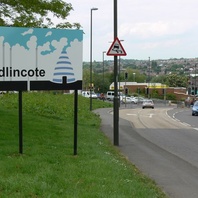
Viking Names
Swadlincote
Swadlincote, in the Repton and Gresley Hundred of Derbyshire, probably comes from the Old Norse male personal name Svartlingr and the Old English element cot ‘cottage, hut, shelter, den’. However, it is possible that the first element may equally well represent the Old English male personal name Sweartling.
Read More
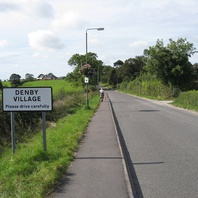
Viking Names
Denby
Denby, in the Morleyston and Litchurch Hundred of Derbyshire, takes its name from the Old English ethnonym Dene ‘a Dane’ and Old Norse by ‘a farmstead, a village’. Traditionally, the place-name has been interpreted as referring to a settlement of Danes. However, the exact implications of such a name are not yet fully understood and are the subject of ongoing work by Dr Jayne Carroll of the Institute for Name-Studies, University of Nottingham.
Read More
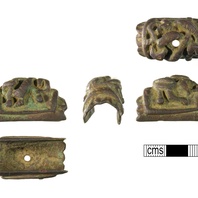
Viking Objects
Urnes-Style Sword Mount (WMID-2FF927)
A cast copper-alloy fitting with Urnes-style, zoomorphic decoration, found near Boylestone, Derbyshire. It may have been a pommel mount and, if so, would have showed off the wealth of the owner.
Read More
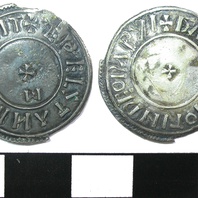
Viking Objects
Silver Penny (1914/543-1)
This silver penny of King Aethelstan, who was King of England from 927-939, was minted in Derby by the moneyer Gadierd between 937-939. It is not known where it was found. Moneyers were people who were permitted to mint money on behalf of the king. Minting coins was a way of controlling the means of exchange within a kingdom and which created a more easily administered standardized system of trade. Moreover, the coins themselves were often used as propaganda, portaying symbols and statements that gave off a desired message. The Vikings later used the minting of coins to legitimize their own rule.
Read More
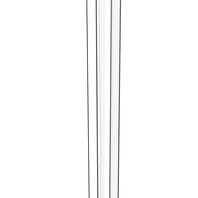
Viking Designs
Drawing of a Viking Sword
This is a drawing of a Viking Age sword which was found in Grave 511 at Repton where the invading Viking Great Army had their winter camp in 873/4. When it was found, the sword had traces of a wooden scabbard attached to the rusted blade. Analysis showed that the scabbard was lined with fleece and covered in leather. The grip was wooden and covered in a woollen textile.
Read More
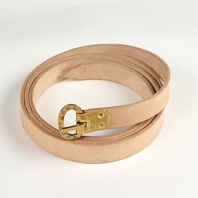
Viking Objects
Reproduction Belt
A vegetable-tanned leather belt with a decorated copper alloy belt buckle. The buckle has a ring and dot pattern and is based on one found in Grave 511 at Repton, Derbyshire.
Read More

Viking Names
Stein
Originally a byname, Steinn ‘stone’ is a very common personal name across Scandinavia. It appears early and remains fairly common as a personal name in both Norway and Iceland. As a personal name, the later form Sten is fairly common in Sweden and Denmark. Several instances are recorded as a byname in Denmark, possibly as a loan from Sweden. The name may also be found in a place-name in Normandy. It is also the first element in Stenson, Derbyshire.
Read More

Viking Names
Temple Normanton
Temple Normanton, in the Scarsdale Hundred of Derbyshire, takes its name from the Old English ethnonym Norðman ‘Northman, Norwegian’ and the Old English element tun ‘farm, settlement’. There are several places of this name, predominantly in the East Midlands: five in Nottinghamshire, also others in Derbyshire, Leicestershire, Lincolnshire and Rutland, and one in the West Riding of Yorkshire. Previously the prefix was North to distinguish it from South Normanton. The prefix Temple refers to previous ownership by the Templars. Traditionally, the place-name has been interpreted as referring to a settlement of Norwegians (in an area where most of the Scandinavian settlers were Danes). However, the exact implications of such a name are not yet fully understood and are the subject of ongoing work by Dr Jayne Carroll of the Institute for Name-Studies, University of Nottingham.
Read More
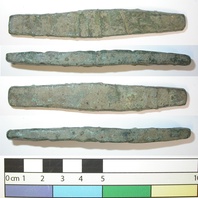
Viking Objects
Copper Alloy Ingot (1986/975-AE29)
This copper alloy ingot was found at the Little Chester Roman fort site near the Roman defences of Derby. This item, alongside others found in the ditches and structures close to the Roman defences, suggests a high level of activity in the area and a significant early medieval presence at this stronghold. Being found in proximity to a stone mould, it is likely that this ingot was used for metalworking, probably of jewellery. Similar ingots are known from Viking period contexts in northern Europe, as at Birka and Lund.
Read More
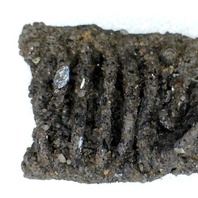
Viking Objects
Silver Wire Embroidery (1988/225-16)
This silver wire was found in Mound 11 at Heath Wood, Ingleby, Derbyshire. This burial mound contained fragments of the remains of an adult human together with the cremated remains of animals, including a small dog, a horse and sheep. The burial was accompanied by this silver wire, an iron spade shoe, some small iron nails and some corroded metalwork. The silver wire was found in two parts with traces of carbonised fibres attached. This suggests that it was probably attached to a piece of cloth. Silver and gold embroidery are known from a number of Viking Age graves, including from nearby Repton, Derbyshire, as well as further afield, e.g. Birka, Sweden. At Birka, wire embroidery was found on caps and headbands, although there is no reason to think that it was only used on headgear at all times.
Read More
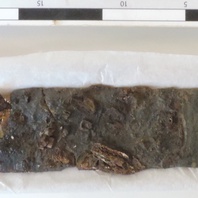
Viking Objects
Sword Blade (1987/590-2)
This fragment of a sword blade was found at the Viking cemetery at Heath Wood, Ingleby in Mound 1. It is incomplete and consists of a 385mm long section of the blade with a rounded tip. the blade has a fuller down the middle to reduce weight. The sword would probably have been over 900mm long when complete, so less than half the blade survives.
